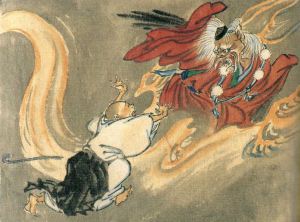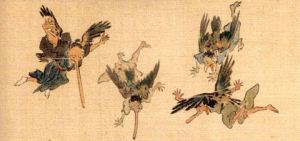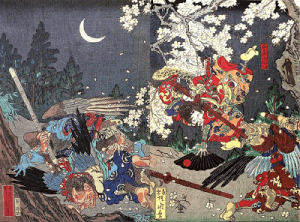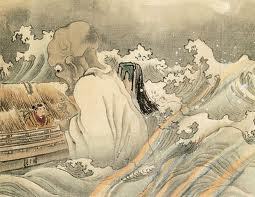Japanese Art and Folklore: Tengu and World of Spirits in the Art of Kawanabe Kyosai
Lee Jay Walker and
Modern Tokyo Times
The Japanese artist Kawanabe Kyosai is extremely fascinating because of his individualistic spirit, which is witnessed in his art. Kyosai, just like the mysterious Tengu, belonged to two worlds and this applies to the old Edo period and the modernization of Japan that began in 1868. The Meiji Restoration of 1868 was truly dynamic and revolutionary – and, likewise, this period also altered the Japanese art scene based on technological advancements and outside influence. Also, the center and periphery relations altered the status quo of the Edo period which relied heavily on stratification.
The Tengu also belongs to two very different traditions and highlights the power of Shintoism and the mysteriousness of this religion. Not only this, the Shinto impact on Buddhist thought patterns and traditions emanating from China were completely turned altered. Therefore, the Tengu becomes part of the richness of nature within the Shinto faith rather than the dark demons of Buddhism and other faiths that highlight the power of evil. This fact also shows the power of Japanese culture because the indigenous faith of Shinto could absorb different thought patterns and traditions.
Kyosai was born in 1831 and died in 1889 therefore the rapid changes in society clearly impacted him. He was an individual who was independent in mind and thought. This reality shines through the art of Kyosai.
Kusumi Kawanabe, Director of the Kawanabe Kyosai Memorial Museum, comments: “This great artist has grown in stature as we have been able the better to get the Meiji period into perspective. He studied at an early age under Kuniyoshi and later under Kano masters, but eventually he went his own independent way. Essentially a nationalistic painter, he was nonetheless fully aware of Western art – indeed, he dealt with it quite broadmindedly in his book “Kyosai Gadan” published in 1887 – but he was robust enough not to succumb, as so many of his contemporaries did, to the blandishments of foreign styles, and was one of the last great painters in the truly Japanese tradition.”
The main focus of this article is to highlight aspects of Kyosai and to link this with the Tengu and the underworld of Japan. After all, mysterious creatures, spirits, and ghosts played a powerful role in the culture of this fascinating country. Also, it is clear that the outside influence of China and Korea greatly impacted Japan. Still, in time many cultural traits would become Japanized based on the power of Japanese culture. This reality can be seen within the indigenous faith of Shintoism and other powerful aspects of culture whereby internal dynamics would absorb and alter past realities.
The yokai represent aspects of the mystery within Japanese folklore and the transformation of the Tengu is also fascinating within the changing thought patterns of Japan. The yokai are creatures with supernatural powers. Therefore, the Tengu is one of the most widely known monster spirits in the land of the rising sun irrespective of various different natures and powers given to the Tengu. After all, the Tengu have constantly gone through many transformations in Japanese folklore. Also, the natural features of the Tengu early artists depicted this mysterious creature with beaks. However, this changed in time because now the most distinctive feature of the Tengu is their long nose.
Within Buddhist thought patterns the Tengu were demons and it was also believed that they were harbingers of bad times. This applies to war and other calamities that would impact negatively on local regions within Japan. However, within Shintoism, the Tengu were sometimes worshiped as revered spirits (Shinto kami) that were blessed with magical powers. Therefore, the Tengu also witnessed the fusion of aspects of Buddhism and Shintoism because in time their image changed into a more protective force.
However, despite this transformation, the Tengu still had dark and dangerous powers. Given this reality, local people in the mountains and forests had to tread carefully because of the several natures of the Tengu. This meant that local people couldn’t take the Tengu for granted therefore great respect was needed during visits to special shrines.
Kyosai certainly depicts the power of the Tengu and the mysterious features and nature of various types of yokai. Therefore, Kyosai is showing images of old Japan despite the new reality of the Meiji period.
In Japanese history the Tengu went from demonic creatures into positive aspects providing great care was taken. If the balance of the real world based on nature was at peace with the underworld then the Tengu could be rightly pacified. For example, if we apply this to children, then in early Japanese history the Tengu were believed to abduct children. However, in later history, this all changed because the Tengu became enlisted in searching for children who were scared and needed help quickly.
Another positive side of the Tengu is that their shape-shifting power applies to animal and human forms. This meant that their attributes were powerful. Therefore, the Tengu used this in order to play tricks on arrogant Buddhist priests or people who abused their power.
In this sense, while the Tengu belongs to Japanese folklore it could be said that Kyosai shared some characteristics of this mysterious creature because he challenged political elites. After all, Kyosai was known for being a political caricaturist therefore he often got into trouble with the dominant political power of his day.
Overall, Kyosai was a free thinker who highlighted the richness of the spirit world in his art and the power of Japanese folklore.
http://kyosai-museum.jp/ENG/about.htm
http://www.onmarkproductions.com/html/tengu.shtml
Modern Tokyo News is part of the Modern Tokyo Times group
http://moderntokyotimes.com Modern Tokyo Times – International News and Japan News
http://sawandjay.com Modern Tokyo Times – Fashion
https://moderntokyonews.com Modern Tokyo News – Tokyo News and International News
http://global-security-news.com Global Security News – Geopolitics and Terrorism
PLEASE JOIN ON TWITTER
https://twitter.com/MTT_News Modern Tokyo Times
PLEASE JOIN ON FACEBOOK






